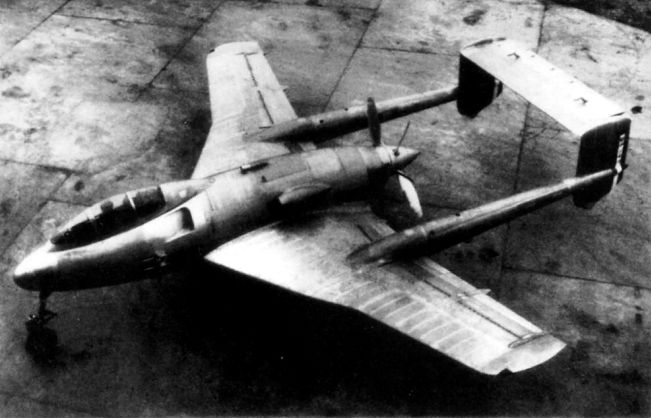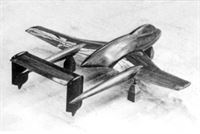
Фотографии
-
Aviation Historian 23 / J.-C.Carbonel - Narval: The dreaded SNCASO SO.8000
The unarmed 02 prototype retained a bare-metal finish throughout its short career, the only markings being tricolour bars on the rudder, which also carried the SNCASO logo, Aeronavale anchor insignia and “S0.8000 No 02”. Titles were also applied to the forward fuselage beneath the cockpit in at least two different typefaces.
-
Мировая Авиация 242
Прототип истребителя палубного базирования S.O.8000 Narval имел необычную двухбалочную компоновку. Силовая установка включала один мотор Jumo 213 французской постройки. Первый полет прототип выполнил в апреле 1949 года.
-
Aviation Historian 23 / J.-C.Carbonel - Narval: The dreaded SNCASO SO.8000
With its swept wings, twin booms and contra-rotating pusher propeller arrangement, the SO.8000 looked every inch the modern naval fighter when it was rolled out in 1948 - but the reality was to be quite different. This is airframe 02, actually the first to fly, with the original elevator without “ears”
-
Aviation Historian 23 / J.-C.Carbonel - Narval: The dreaded SNCASO SO.8000
The first SO.8000 to be completed was airframe 02, which is seen here shortly after its rollout, with the original tailplane configuration (contained within the fins) and radio mast fitted beneath the fuselage (later relocated to the top of the fuselage aft of the cockpit). Undercarriage doors were later fitted to this prototype, but were left off for most of the early part of the test programme.
-
Aviation Historian 23 / J.-C.Carbonel - Narval: The dreaded SNCASO SO.8000
Airframe 02 at an unknown location after its various modifications, including the resetting of the empennage at an increased negative incidence and the addition of a supplementary vane in the air intake to solve airflow problems. Note also the stylised “Narval” legend on the forward fuselage, later changed to simpler block lettering reading “S.O. Narval”.
-
Aviation Historian 23 / J.-C.Carbonel - Narval: The dreaded SNCASO SO.8000
Following 02’s maiden flight on April 1, 1949, the aircraft was substantially modified, with the addition of a larger elevator extending beyond the lateral confines of the fins, providing "ears". The tail’s incidence was also altered and “deflector planes”, visible on the port outer wing here, were fitted to the spoilers to improve handling.
-
Aviation Historian 23 / J.-C.Carbonel - Narval: The dreaded SNCASO SO.8000
Регистрационный номер: F-WFKV Airframe 02 was given the French civil registration F-WFKV (the F-W- sequence being reserved for test aircraft and delivery flights), probably late in its short career. It is seen here taxying out for a flight, by this time with main wheel undercarriage doors fitted and with the one-piece extended elevator deflected fully upwards.
-
Aviation Historian 23 / J.-C.Carbonel - Narval: The dreaded SNCASO SO.8000
ery few photographs of airframe 01 appear to exist, this example showing the aircraft under construction at Courbevoie. Note the gun troughs located in the forward fuselage; only 01 was fitted with these, along with the armoured windscreen and forward canopy section, seen here on the floor to the right of the nosewheel leg.
-
Aviation Historian 23 / J.-C.Carbonel - Narval: The dreaded SNCASO SO.8000
An extremely rare photograph of both Narval airframes together, albeit during scrapping, with the gun troughs on the right-hand example marking it as 01, with its armoured windscreen on the ground alongside. The Aeronavale ultimately replaced its Dauntlesses with more American types - the F6F Hellcat and Curtiss Helldiver.
-
Aviation Historian 23 / J.-C.Carbonel - Narval: The dreaded SNCASO SO.8000
Looking very much like a de Havilland Venom with a high-set tailplane, this 1946 display model shows the proposed early configuration of the SO.8000 with a distinctive compound swept wing and tip tank/pods. The model wears Aeronavale roundels and an overall white finish, standard for French Navy aircraft at that time.
-
Aviation Historian 23 / J.-C.Carbonel - Narval: The dreaded SNCASO SO.8000
This solid polished-wood windtunnel model of the Narval, as the type was named, has no apertures to represent air intakes, and the “bumpers” below each fin are oversized, so it was probably used for more general research into the type’s aerodynamic form. It is unknown whether any of the Narval’s handling problems were flagged up during windtunnel testing.
-
Aviation Historian 23 / J.-C.Carbonel - Narval: The dreaded SNCASO SO.8000
A contemporary drawing of the SO.8000 showing the powerplant arrangement and position of the pilot, and fitted with the elevator "ears" adopted after the first flight. The fairings mounted beneath the booms were intended to carry radar and radio equipment on production aircraft.
-
Aviation Historian 23 / J.-C.Carbonel - Narval: The dreaded SNCASO SO.8000
Although of unusual configuration, the S0.8000 Narval was essentially of conventional all-metal construction, fitted with wings incorporating double-slotted retractable Fowler-type flaps, lateral control being effected by means of spoilers and, on 01, small ailerons












